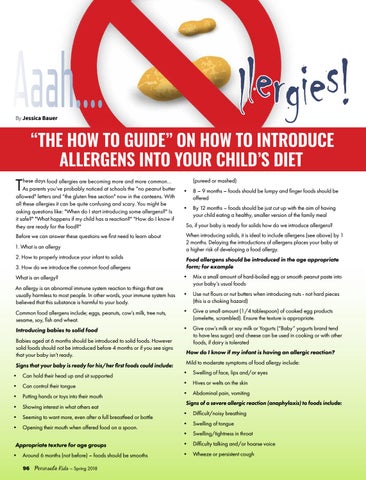Aaah.. .
ll ergies!
By Jessica Bauer
“THE HOW TO GUIDE” ON HOW TO INTRODUCE ALLERGENS INTO YOUR CHILD’S DIET
T
hese days food allergies are becoming more and more common… As parents you’ve probably noticed at schools the “no peanut butter allowed" letters and “the gluten free section" now in the canteens. With all these allergies it can be quite confusing and scary. You might be asking questions like: "When do I start introducing some allergens?" Is it safe?" "What happens if my child has a reaction?" "How do I know if they are ready for the food?"
Before we can answer these questions we first need to learn about 1. What is an allergy 2. How to properly introduce your infant to solids 3. How do we introduce the common food allergens What is an allergy? An allergy is an abnormal immune system reaction to things that are usually harmless to most people. In other words, your immune system has believed that this substance is harmful to your body.
(pureed or mashed) • 8 – 9 months – foods should be lumpy and finger foods should be offered • By 12 months – foods should be just cut up with the aim of having your child eating a healthy, smaller version of the family meal So, if your baby is ready for solids how do we introduce allergens? When introducing solids, it is ideal to include allergens (see above) by 1 2 months. Delaying the introductions of allergens places your baby at a higher risk of developing a food allergy. Food allergens should be introduced in the age appropriate form; for example • Mix a small amount of hard-boiled egg or smooth peanut paste into your baby’s usual foods • Use nut flours or nut butters when introducing nuts - not hard pieces (this is a choking hazard)
Common food allergens include; eggs, peanuts, cow’s milk, tree nuts, sesame, soy, fish and wheat.
• Give a small amount (1/4 tablespoon) of cooked egg products (omelette, scrambled). Ensure the texture is appropriate.
Introducing babies to solid food
• Give cow’s milk or soy milk or Yogurts (“Baby” yogurts brand tend to have less sugar) and cheese can be used in cooking or with other foods, if dairy is tolerated
Babies aged at 6 months should be introduced to solid foods. However solid foods should not be introduced before 4 months or if you see signs that your baby isn’t ready. Signs that your baby is ready for his/her first foods could include: • Can hold their head up and sit supported • Can control their tongue • Putting hands or toys into their mouth • Showing interest in what others eat • Seeming to want more, even after a full breastfeed or bottle • Opening their mouth when offered food on a spoon. Appropriate texture for age groups • Around 6 months (not before) – foods should be smooths 96
Peninsula Kids – Spring 2018
How do I know if my infant is having an allergic reaction? Mild to moderate symptoms of food allergy include: • Swelling of face, lips and/or eyes • Hives or welts on the skin • Abdominal pain, vomiting Signs of a severe allergic reaction (anaphylaxis) to foods include: • Difficult/noisy breathing • Swelling of tongue • Swelling/tightness in throat • Difficulty talking and/or hoarse voice • Wheeze or persistent cough
